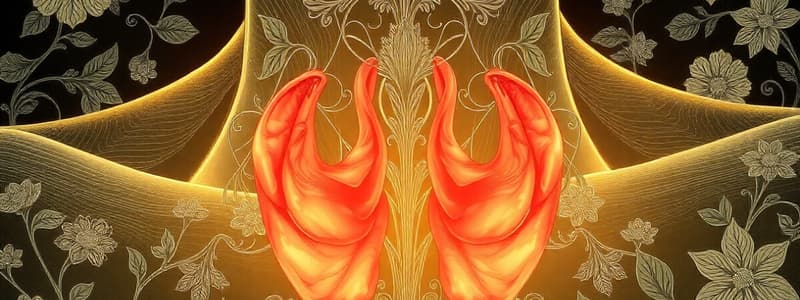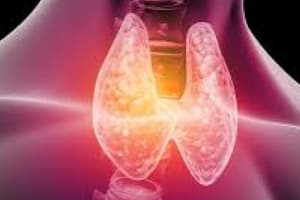Podcast
Questions and Answers
A patient presents with symptoms of hyperthyroidism. Initial lab results show low TSH and elevated T3 and T4. Which diagnostic test would best help differentiate between Graves' disease and toxic multinodular goitre?
A patient presents with symptoms of hyperthyroidism. Initial lab results show low TSH and elevated T3 and T4. Which diagnostic test would best help differentiate between Graves' disease and toxic multinodular goitre?
- Complete blood count to assess for signs of infection or inflammation.
- Thyroid ultrasound to assess nodule size and characteristics.
- Measurement of serum calcium levels to rule out parathyroid involvement.
- Radioactive iodine uptake scan (I-123) to evaluate thyroid activity distribution. (correct)
During the biosynthesis of thyroid hormones, which step is directly responsible for incorporating iodine into thyroglobulin?
During the biosynthesis of thyroid hormones, which step is directly responsible for incorporating iodine into thyroglobulin?
- Oxidation and iodination of tyrosine residues. (correct)
- Proteolysis of thyroglobulin.
- Deiodination of iodotyrosines.
- Iodide trapping by follicular cells.
A patient is diagnosed with a toxic thyroid adenoma. What is the most critical characteristic that differentiates this condition from thyroid cancer?
A patient is diagnosed with a toxic thyroid adenoma. What is the most critical characteristic that differentiates this condition from thyroid cancer?
- The ability of the adenoma to metastasize to distant sites.
- The rapid growth rate of the nodule compared to normal thyroid tissue.
- The presence of elevated serum thyroglobulin levels.
- The benign nature of the adenoma, lacking metastatic potential. (correct)
A patient with hyperthyroidism has a uniformly enlarged thyroid gland and elevated levels of anti-TSH receptor antibodies. Which of the following pathophysiological mechanisms is most likely responsible for their condition?
A patient with hyperthyroidism has a uniformly enlarged thyroid gland and elevated levels of anti-TSH receptor antibodies. Which of the following pathophysiological mechanisms is most likely responsible for their condition?
During thyroid hormone synthesis, after iodide trapping, which subsequent step directly facilitates the incorporation of iodine into the thyroglobulin molecule?
During thyroid hormone synthesis, after iodide trapping, which subsequent step directly facilitates the incorporation of iodine into the thyroglobulin molecule?
Which of the following mechanisms explains how thioureylenes reduce thyroid hormone levels?
Which of the following mechanisms explains how thioureylenes reduce thyroid hormone levels?
Why is there a latent period of 2-4 weeks before clinical improvement is observed after initiating treatment with thio(n)amides?
Why is there a latent period of 2-4 weeks before clinical improvement is observed after initiating treatment with thio(n)amides?
A patient is being treated for hyperthyroidism with propylthiouracil (PTU). Which additional mechanism, beyond TPO inhibition, contributes to PTU's therapeutic effect?
A patient is being treated for hyperthyroidism with propylthiouracil (PTU). Which additional mechanism, beyond TPO inhibition, contributes to PTU's therapeutic effect?
Carbimazole is administered as a prodrug. What is its active metabolite?
Carbimazole is administered as a prodrug. What is its active metabolite?
Considering the pharmacokinetic differences between propylthiouracil (PTU) and methimazole, which statement accurately compares their properties?
Considering the pharmacokinetic differences between propylthiouracil (PTU) and methimazole, which statement accurately compares their properties?
A patient with Graves' disease is prescribed propylthiouracil (PTU). Which mechanism of action primarily accounts for PTU's therapeutic effect in managing their hyperthyroidism?
A patient with Graves' disease is prescribed propylthiouracil (PTU). Which mechanism of action primarily accounts for PTU's therapeutic effect in managing their hyperthyroidism?
A patient is diagnosed with hypothyroidism and started on levothyroxine. After several weeks, the patient reports persistent fatigue, weight gain, and constipation, despite taking the medication as prescribed. What is the MOST appropriate next step in managing this patient's condition?
A patient is diagnosed with hypothyroidism and started on levothyroxine. After several weeks, the patient reports persistent fatigue, weight gain, and constipation, despite taking the medication as prescribed. What is the MOST appropriate next step in managing this patient's condition?
A patient with hyperparathyroidism is being treated with cinacalcet. Which mechanism BEST explains how cinacalcet reduces serum calcium levels?
A patient with hyperparathyroidism is being treated with cinacalcet. Which mechanism BEST explains how cinacalcet reduces serum calcium levels?
A patient with postsurgical hypoparathyroidism is prescribed calcium and vitamin D supplements. Despite adherence to the treatment plan, the patient continues to experience symptoms of hypocalcemia. What additional treatment strategy should be considered to improve calcium levels?
A patient with postsurgical hypoparathyroidism is prescribed calcium and vitamin D supplements. Despite adherence to the treatment plan, the patient continues to experience symptoms of hypocalcemia. What additional treatment strategy should be considered to improve calcium levels?
A 30-year-old female is diagnosed with hyperthyroidism and started on methimazole. She returns after a month complaining of a sore throat and fever. A complete blood count reveals a significantly decreased white blood cell count (neutropenia). What is the most appropriate course of action?
A 30-year-old female is diagnosed with hyperthyroidism and started on methimazole. She returns after a month complaining of a sore throat and fever. A complete blood count reveals a significantly decreased white blood cell count (neutropenia). What is the most appropriate course of action?
Flashcards
Hyperthyroidism
Hyperthyroidism
A condition with excess thyroid hormone causing increased metabolism.
Hypothyroidism
Hypothyroidism
A condition where the thyroid gland produces insufficient hormone.
Thyroid Gland Treatment
Thyroid Gland Treatment
Drugs used to treat hyperthyroidism or hypothyroidism via specific mechanisms.
Pharmacokinetics
Pharmacokinetics
Signup and view all the flashcards
Parathyroid Gland Treatment
Parathyroid Gland Treatment
Signup and view all the flashcards
Graves' disease
Graves' disease
Signup and view all the flashcards
Toxic thyroid adenoma
Toxic thyroid adenoma
Signup and view all the flashcards
Diagnosis of hyperthyroidism
Diagnosis of hyperthyroidism
Signup and view all the flashcards
Iodine in imaging
Iodine in imaging
Signup and view all the flashcards
Biosynthesis of thyroid hormones
Biosynthesis of thyroid hormones
Signup and view all the flashcards
T3 & T4 Formation
T3 & T4 Formation
Signup and view all the flashcards
Thio(n)amides
Thio(n)amides
Signup and view all the flashcards
Thyroperoxidase (TPO)
Thyroperoxidase (TPO)
Signup and view all the flashcards
Half-life of PTU vs Methimazole
Half-life of PTU vs Methimazole
Signup and view all the flashcards
Latent period for clinical improvement
Latent period for clinical improvement
Signup and view all the flashcards
Study Notes
Pharmacological Control of the Thyroid and Parathyroid Gland
- Developed by Prof. Steve Kerrigan (Professor Personalised Therapeutics)
- Delivered in Bahrain by Prof Will Ford
- Topics covered include the pharmacological control of the thyroid and parathyroid glands, including learning outcomes, diseases of the thyroid (hyperthyroidism and hypothyroidism), causes of hyperthyroidism, signs and symptoms of hyperthyroidism, diagnosis of hyperthyroidism, imaging in hyperthyroidism, biosynthesis of thyroid hormones, treatment options, thio(n)amides/thioureylenes (mechanism of action, clinical use, pharmacokinetics, side effects), short range emission radioactive iodine (clinical use, mechanism of action, pharmacokinetics, adverse effects), surgery (equally effective treatment for Graves' disease, reasons for choosing surgery), adjunctive therapy, hypothyroidism (major causes, signs and symptoms), treatment with levothyroxine (LT3) (clinical uses, mechanism of action, side effects, pharmacokinetics), and TSH monitoring.
- Also includes disorders of parathyroid function, primary hyperparathyroidism causes, treatment options, calcimimetics, bisphosphonates, disorders of hypoparathyroidism, causes, calcium salts, Vitamin D, and learning outcomes for each topic.
Learning Outcomes
- Thyroid Gland: Treatment
- LO1: Describe the mechanism of action of the drugs used to treat either hyperthyroidism or hypothyroidism
- LO2: Recall the pharmacokinetics and side effects associated with each treatment for either hyperthyroidism or hypothyroidism
- Parathyroid Gland: Treatment
- LO3: Describe the mechanism of action of the drugs used to treat either hyperparathyroidism or hypoparathyroidism
- LO4: Recall the pharmacokinetics and side effects associated with each treatment for hyperparathyroidism or hypothyroidism
Diseases of the Thyroid
- Hyperthyroidism: Excess thyroid hormone, causing overactive metabolism and increased speed of body processes.
- Hypothyroidism: Insufficient production of thyroid hormone by the thyroid gland, causing slowed body functions.
Hyperthyroidism: Causes
- Graves' disease (Autoimmune disease affecting TSH receptor)
- Toxic thyroid adenoma (Benign tumor, can't metastasize)
- Toxic multinodular goitre (Overgrowth of gland)
Hyperthyroidism: Signs and Symptoms
- Intolerance to heat
- Fine, straight hair
- Bulging eyes
- Facial flushing
- Enlarged thyroid
- Tachycardia
- Increased systolic blood pressure
- Breast enlargement
- Weight loss
- Muscle wasting
- Localized edema
Hyperthyroidism: Diagnosis
- Laboratory: Serum TSH (low), Serum T3 and T4 (high), Anti-TSH receptor antibodies
- Imaging: Thyroid ultrasound, Radioactive iodine (1123) imaging
Hyperthyroidism: Imaging
- Radioactive imaging using iodine (1123): used to determine cause of hyperthyroidism.
Biosynthesis of Thyroid Hormones
- Iodide trapping
- Oxidation and iodination of tyrosine residues on Tg
- Coupling of iodotyrosine to form T3 & T4
- Proteolysis of Tg, releasing T4, T3, and iodotyrosines
- Deiodination
Treatment Options for Hyperthyroidism
- Thioureylenes (e.g., carbimazole, methimazole, propylthiouracil)
- Radioactive iodine (131I)
- Surgery (total thyroidectomy)
Adjunctive Therapy
- Beta-adrenoceptor antagonists (e.g., propranolol) - Used to treat symptoms of hyperthyroidism while other treatments take effect
- Corticosteroids
- Nonsteroidal anti-inflammatory drugs (NSAIDs)
Hypothyroidism: Causes
- Hashimoto's thyroiditis (destruction of thyroid tissue by circulating antibodies)
- Genetic factors
- Iatrogenic factors (e.g., post-thyroidectomy, radiation therapy)
Hypothyroidism: Signs and Symptoms
- Intolerance to cold
- Receding hairline
- Facial and eyelid edema
- Dull-blank expression
- Extreme fatigue
- Thick tongue
- Slow speech
- Anorexia
- Brittle nails and hair
- Menstrual disturbances
- Late clinical manifestations: subnormal temperature, bradycardia, weight gain, thickened skin, cardiac complications.
Treatment with Levothyroxine (LT3):
- Synthetic thyroxine derivative, used in hormone replacement therapy
- T4 is metabolically converted to T3
- Infrequently used alone but often combined with T4, for instance in myxedema coma
- Side effects include: palpitations, nervousness, headache, difficulty sleeping, insomnia, swelling of the legs/ankles, weight loss, and appetite changes.
TSH Monitoring
- Frequency of monitoring: Every 6 weeks (or until normalized)
- Target TSH normal range: 0.5 – 4.5 mIU/L (typical target is 0.5-2.5 mIU/L; higher targets (1-6 mIU/L) in older people
Disorders of Parathyroid Function
-
Hyperparathyroidism: Excessive parathyroid hormone (PTH) causes high calcium in the blood: -Causes include a noncancerous growth (adenoma) on a gland, enlarged glands, and, more rarely, cancer. -Symptoms/results include osteoporosis, kidney stones, renal dysfunction.
-
Hypoparathyroidism: Inadequate parathyroid hormone (PTH): -Causes include post-surgical damage or removal, infiltrative diseases (e.g., hemochromatosis), and hypomagnesemia. -Symptoms include cardiac arrhythmias, neuromuscular irritability, tingling of the fingers/toes, and tetany.
Calcium Salts
- Mechanism of action: replaces calcium in the body, improves bone mineralization, regulates nervous/muscle tissues
- Pharmacokinetics: oral solution only
- Side effects: mainly constipation, chronic kidney disease, kidney stones
Vitamin D
- Biosynthesis and Transport: Vitamin D is converted to its active form, calcitriol, which binds to a vitamin D-binding protein then transported throughout the body
- Mechanism of action: promotes calcium absorption in the intestines, maintains calcium/phosphate levels for bone mineralization
- Side effects: allergic skin reactions, calcium build-up in arteries, changes in cholesterol levels
- Monitoring: serum and urinary calcium levels
Other important learning points
- Agranulocytosis (as a major side effect of thio(n)amides): risk is approximately 0.1–0.5%; stop antithyroid medication, check WBC with differential for fever, sore throat, and if count <500, give antibiotics, then resume drug; may be fatal.
- When to use which drugs for Graves' disease treatment.
- Treatment options for hyperparathyroidism: surgery is the treatment of choice; minimally invasive (MIRP)
- Treatment for hypoparathyroidism: Calcium and 1,25-dihydroxy vitamin D
Studying That Suits You
Use AI to generate personalized quizzes and flashcards to suit your learning preferences.
Related Documents
Description
Explore the pharmacological control of the thyroid and parathyroid glands. Covers hyperthyroidism, hypothyroidism, diagnosis, and treatment options. Details the use of thio(n)amides, radioactive iodine, and levothyroxine.




